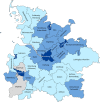Regional differences in reasons for consultation and general practitioners' spectrum of services in northern Germany - results of a cross-sectional observational study
- PMID: 32005159
- PMCID: PMC6995090
- DOI: 10.1186/s12875-020-1093-6
Regional differences in reasons for consultation and general practitioners' spectrum of services in northern Germany - results of a cross-sectional observational study
Abstract
Background: Among other factors, the patients' consultation reasons and GPs' spectrum of services determine the process and outcome of the medical treatment. So far, however, there has been little information on differences in reasons for consultation and GPs' services between urban and rural areas. Our study's goal was thus to investigate these factors in relation to the regional location of GPs' practices.
Methods: We conducted a cross-sectional observational study based on standardised GP interviews in a quota sampling design. All counties and independent cities within a radius of 120 km around Hamburg were divided into three regional categories (urban area, environs, rural area) and stratified proportionally to the population size. Differences in the number of reasons for consultation and services were analysed by multivariate linear regressions in mixed models adjusted for random effects on the levels of the German federal states and administrative districts. Differences in individual consultation reasons and services were identified by logistic regression via stepwise forward and backward selection.
Results: Primary care practices in 34 of the 37 selected administrative districts (91.9%) were represented in the dataset. In total, 211 GPs were personally interviewed. On average, GPs saw 344 patients per month with a slightly higher number of patients in rural areas. They reported 59.1 ± 15.4 different reasons for consultation and 30.3 ± 3.9 different services. There was no statistically significant regional variation in the number of different consultation reasons, but there was a broader service spectrum by rural GPs (ß = - 1.42; 95% confidence interval - 2.75/- 0.08; p = 0.038) which was statistically explained by a higher level of medical training. Additionally, there were differences in the frequency of individual consultation reasons and services between rural and urban areas.
Conclusion: GPs in rural areas performed more frequently services usually provided by medical specialists in urban areas. This might be caused by a low availability of specialists in rural areas. The association between medical training and service spectrum might imply that GPs compensate the specific needs of their patients by completing advanced medical training before or after setting up a medical practice.
Trial registration: The study was registered in ClinicalTrials.gov (NCT02558322).
Keywords: General practice; Healthcare utilisation; Reasons for consultation; Regional comparison; Urban-rural differences.
Conflict of interest statement
The authors declare that they have no competing interests.
Figures

Similar articles
-
Regional and patient-related factors influencing the willingness to use general practitioners as coordinators of the treatment in northern Germany - results of a cross-sectional observational study.BMC Fam Pract. 2020 Jun 17;21(1):110. doi: 10.1186/s12875-020-01180-3. BMC Fam Pract. 2020. PMID: 32552721 Free PMC article.
-
The effect of COVID-19 pandemic and lockdown on consultation numbers, consultation reasons and performed services in primary care: results of a longitudinal observational study.BMC Fam Pract. 2021 Jun 23;22(1):125. doi: 10.1186/s12875-021-01471-3. BMC Fam Pract. 2021. PMID: 34162343 Free PMC article.
-
Regional variation of patient behaviour and reasons for consultation in the general practice of Northern Germany: protocol for an observational study.BMJ Open. 2016 Jun 29;6(6):e010738. doi: 10.1136/bmjopen-2015-010738. BMJ Open. 2016. PMID: 27357194 Free PMC article.
-
[Assessment of the occupational perspectives of general practitioners in a rural area. Results from the study HaMedSi (Hausärzte [GPs] for Medical education in Siegen-Wittgenstein)].MMW Fortschr Med. 2019 Oct;161(Suppl 6):9-14. doi: 10.1007/s15006-019-0919-4. Epub 2019 Oct 5. MMW Fortschr Med. 2019. PMID: 31587169 Review. German.
-
Improving the referral process for familial breast cancer genetic counselling: findings of three randomised controlled trials of two interventions.Health Technol Assess. 2005 Feb;9(3):iii-iv, 1-126. doi: 10.3310/hta9030. Health Technol Assess. 2005. PMID: 15694064 Review.
Cited by
-
Regional and patient-related factors influencing the willingness to use general practitioners as coordinators of the treatment in northern Germany - results of a cross-sectional observational study.BMC Fam Pract. 2020 Jun 17;21(1):110. doi: 10.1186/s12875-020-01180-3. BMC Fam Pract. 2020. PMID: 32552721 Free PMC article.
-
Development and feasibility of a function-based preventive intervention for lifestyle-related disorders.BMC Public Health. 2024 Mar 4;24(1):681. doi: 10.1186/s12889-024-18017-8. BMC Public Health. 2024. PMID: 38438859 Free PMC article.
-
Regional differences in the patient population of general practices in northern Germany: results of a mixed-methods study.BMJ Open. 2020 Nov 27;10(11):e041762. doi: 10.1136/bmjopen-2020-041762. BMJ Open. 2020. PMID: 33247029 Free PMC article. Clinical Trial.
-
Sex differences in patterns of referral and resource utilization in the cardiology clinic: an outpatient analysis.Front Cardiovasc Med. 2023 Jul 31;10:1202960. doi: 10.3389/fcvm.2023.1202960. eCollection 2023. Front Cardiovasc Med. 2023. PMID: 37588036 Free PMC article.
-
Developing and testing a framework for coding general practitioners' free-text diagnoses in electronic medical records - a reliability study for generating training data in natural language processing.BMC Prim Care. 2024 Jul 16;25(1):257. doi: 10.1186/s12875-024-02514-1. BMC Prim Care. 2024. PMID: 39014311 Free PMC article.
References
-
- Busse R, Blümel M. Germany: health system review. Health Syst Transit. 2014;16(2):1–296. - PubMed
-
- Kassenärztliche Bundesvereinigung. Die Bedarfsplanung als Instrument zur Sicherstellung der ambulanten Versorgung. https://www.kbv.de/html/bedarfsplanung.php. Accessed 24 Sept 2019.
-
- Kroll LE, Lampert T. Regionale Unterschiede in der Gesundheit am Beispiel von Adipositas und Diabetes mellitus. In: Robert Koch-Institut (Hrsg.) Daten und Fakten: Ergebnisse der Studie» Gesundheit in Deutschland. Berlin, 2010: 51–59. http://www.gbe-bund.de/pdf/GEDA_2010_5_Adipositas_Diabetes_mellitus.pdf. Accessed 17 Jan 2019.
-
- Erhart M, von Stillfried D. Analyse regionaler Unterschiede in der Prävalenz und Versorgung depressiver Störungen auf Basis vertragsärztlicher Abrechnungsdaten – Teil 1 Prävalenz. Berlin: Zentralinstitut für die kassenärztliche Versorgung in Deutschland; 2012.
-
- Maretzke S. Regionale Unterschiede in der Altersstruktur. In: Leibniz-Institut für LänderkundeKemper FJ, Gans P, editors. Bundesrepublik Deutschland : Nationalatlas. Band 4. Bevölkerung. Heidelberg: Springer Spektrum; 2012.
Publication types
MeSH terms
Associated data
LinkOut - more resources
Full Text Sources
Medical

